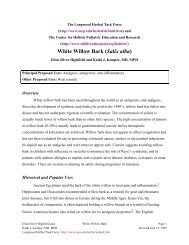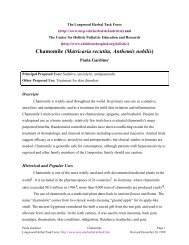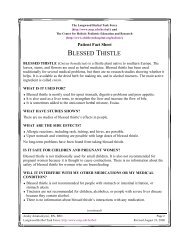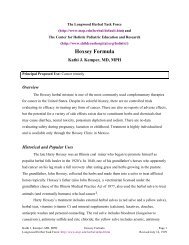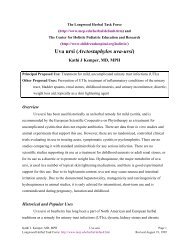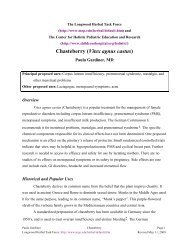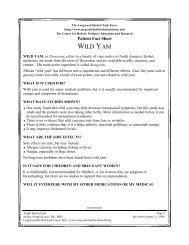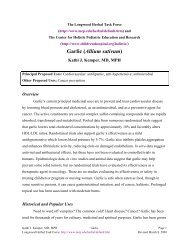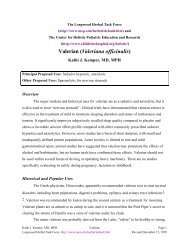Milk Thistle (Silybum marianum) - Longwood Herbal Task Force
Milk Thistle (Silybum marianum) - Longwood Herbal Task Force
Milk Thistle (Silybum marianum) - Longwood Herbal Task Force
Create successful ePaper yourself
Turn your PDF publications into a flip-book with our unique Google optimized e-Paper software.
The <strong>Longwood</strong> <strong>Herbal</strong> <strong>Task</strong> <strong>Force</strong><br />
(http://www.mcp.edu/herbal/default.htm) and<br />
The Center for Holistic Pediatric Education and Research<br />
(http://www.childrenshospital.org/holistic/)<br />
<strong>Milk</strong> <strong>Thistle</strong> (<strong>Silybum</strong> <strong>marianum</strong>)<br />
Jane M. Murphy, RNC, MS, PNP, Mary Caban, BS, MPH<br />
and Kathi J. Kemper, MD, MPH<br />
Principal Proposed Uses: Hepatoprotectant, enhancement of biliary function<br />
Other Proposed Uses: Renal protectant, anti-inflammatory<br />
Overview<br />
<strong>Milk</strong> thistle is widely used in Europe for hepatic and biliary disorders, and is beginning to<br />
be used to protect against nephrotoxicity as well. It protects the liver from several hepatotoxins,<br />
including Amanita mushrooms, acetaminophen and alcohol. Its primary active ingredient is<br />
silymarin, which is a potent antioxidant composed of several flavonoid compounds. Further studies<br />
are needed to evaluate milk thistle's renal protectant effects, such as prevention of cisplatin toxicity,<br />
its use in treating alcoholic liver disease, and its use to prevent cancer or as a complementary<br />
treatment for cancer. There are no known long-term risks to adults associated with milk thistle use.<br />
Its safety in pediatrics, pregnancy, and during lactation are unknown.<br />
Historical and Popular Uses<br />
<strong>Milk</strong> thistle has been used medicinally in Europe since the first century. Pliny the Elder<br />
claimed that it was helpful in improving bile flow. It was also mentioned in the writings of<br />
Dioscorides, Jacobus Theodorus and Culpepper 1 . Its leaves, flowers and roots have historically<br />
been considered a vegetable in European diets, and its fruits (achenes), which resemble seeds, have<br />
been roasted for use as a coffee substitute. The leaves of the plant are eaten in fresh salads and as a<br />
spinach substitute, the stalks eaten like asparagus, and the flower heads served as one would an<br />
artichoke.<br />
Jane M. Murphy, RNC, MS, PNP <strong>Milk</strong> <strong>Thistle</strong> Page 1<br />
Mary Caban, BS, MPH<br />
and Kathi J. Kemper, MD, MPH<br />
<strong>Longwood</strong> <strong>Herbal</strong> <strong>Task</strong> <strong>Force</strong>: http://www.mcp.edu/herbal/default.htm Revised February 16, 2000
In Traditional Chinese Medicine, milk thistle seeds are known as Shui Fei Ji; in China milk<br />
thistle is used to protect the liver, increase bile secretion and protect against oxidative injuries such<br />
as radiation.<br />
Ripe milk thistle seeds are used in Europe in the treatment of various hepatobiliary<br />
problems, such as hepatitis, cirrhosis, gallstones, and jaundice, as well as for kidney ailments 2 .<br />
<strong>Milk</strong> thistle is used as an antidote for Amanita mushroom poisoning and to protect the liver and<br />
kidneys from toxic medications 3 . It is used to treat hepatitis and biliary disease, lower cholesterol,<br />
and even improve psoriasis. Some herbalists also recommend it to treat insufficient lactation. The<br />
German Commission E recommends it for the treatment of dyspeptic complaints, toxin-induced<br />
liver damage, and hepatic cirrhosis and as a supportive therapy for chronic inflammatory liver<br />
conditions 4 ; sales there exceeded $180 million in 1997 5 .<br />
Botany<br />
Medicinal species: <strong>Silybum</strong> <strong>marianum</strong> L. Gaertn., Cardus marianus L.<br />
Common names: Holy thistle, marian thistle, Mary thistle, milk thistle, Our Lady’s thistle, St. Mary<br />
thistle, wild artichoke, Mariendistel (Ger), Chardon-Marie (Fr) 6 , 7 . <strong>Milk</strong> thistle should not<br />
be confused with blessed thistle, Cnicus benedictus. <strong>Milk</strong> thistle is sold as Legalon ® in<br />
Germany.<br />
Botanical family: Compositae/Asteraceae<br />
Plant description: <strong>Milk</strong> thistle is a tall, biennial herb, five to ten feet high, with hard, green, shiny<br />
leaves that have spiny edges and are streaked with white along the veins. The solitary<br />
flower heads are reddish-purple with bracts ending in sharp spines. The small hard fruits in<br />
the flowers, known technically as achenes, resemble seeds and are the part of the plant used<br />
medicinally.<br />
Where it’s grown: Southern and western Europe, South America and North America in the eastern<br />
United States and California.<br />
Jane M. Murphy, RNC, MS, PNP <strong>Milk</strong> <strong>Thistle</strong> Page 2<br />
Mary Caban, BS, MPH<br />
and Kathi J. Kemper, MD, MPH<br />
<strong>Longwood</strong> <strong>Herbal</strong> <strong>Task</strong> <strong>Force</strong>: http://www.mcp.edu/herbal/default.htm Revised February 16, 2000
Biochemistry<br />
<strong>Milk</strong> <strong>Thistle</strong>: Potentially Active Chemical Constituents<br />
• Flavonoids/flavonolignans: silymarin (which includes silybin [silibinin], silidianin, silychristin<br />
[silichristin] and isosylibin), apigenin, dehydrosilybin, deoxysilycristin, deoxysildianin,<br />
siliandrin, silybinome, silyhermin, neosilyhermin Other: silybonol; myristic, oleic, palmitic and<br />
stearic acids; betaine hydrochloride<br />
The dried seeds contain 1-4% silymarin flavonoids 8 . Silymarin is a mixture of at least three<br />
flavonolignans, including silybin (silibinin), silidianin, and silychristin. It is the primary active<br />
ingredient in milk thistle, and is also found in related species such as artichokes.<br />
The bioavailability of enterally administered silymarin is limited; the compound is poorly<br />
soluble in water, and only 20-50% is absorbed from the gastrointestinal tract after ingestion.<br />
Absorption is significantly enhanced if silybin is administered in a complex with<br />
phosphatidlycholine 9, 10 . There is rapid absorption after an oral dose with the peak plasma<br />
concentration reached after two to four hours and an elimination half-life of six hours 5 ; it<br />
undergoes extensive enterohepatic circulation. Three to eight percent is excreted in the urine, and<br />
80% is excreted in the bile as glucuronide and sulfate conjugates 11 . Bioavailability can vary up to<br />
three-fold depending on the formulation; the brand used in most European studies, Legalon ® ,<br />
contains approximately twice as much available silybin as other preparations12, 13<br />
Silybin is the most biologically active component with regard to antioxidant and<br />
hepatoprotective properties; it is concentrated in the bile, achieving concentrations 60 times higher<br />
than that found in the serum 14, 15 .<br />
Other flavonolignans identified in S. <strong>marianum</strong> include dehydrosilybin, deoxysilycistin,<br />
deoxysilydianin, silandrin, silybinome, silyhermin and neosilyhermin. In addition, milk thistle<br />
contains apigenin; silybonol; myristic, oliec, palmitic and stearic acids; and betaine hydrochloride,<br />
which may have a hepatoprotective effect 16 .<br />
Jane M. Murphy, RNC, MS, PNP <strong>Milk</strong> <strong>Thistle</strong> Page 3<br />
Mary Caban, BS, MPH<br />
and Kathi J. Kemper, MD, MPH<br />
<strong>Longwood</strong> <strong>Herbal</strong> <strong>Task</strong> <strong>Force</strong>: http://www.mcp.edu/herbal/default.htm Revised February 16, 2000
Experimental Studies<br />
1. Cardiovascular: none<br />
2. Pulmonary: none<br />
Potential Clinical Benefits of <strong>Milk</strong> <strong>Thistle</strong><br />
3. Renal and electrolyte balance: Renal protectant<br />
4. Gastrointestinal/hepatic: Hepatoprotectant; treatment of hepatitis, antilipidemic<br />
5. Neuro-psychiatric: none<br />
6. Endocrine: Antidiabetic and pancreatic protectant<br />
7. Hematologic: none<br />
8. Rheumatologic: none<br />
9. Reproductive: none<br />
10. Immune modulation: Anti-inflammatory<br />
11. Antimicrobial: none<br />
12. Antineoplastic: Chemoprevention<br />
13. Antioxidant: Antioxidant<br />
14. Skin and mucus membranes: Psoriasis: Traditional use, no data.<br />
15. Other/miscellaneous: none<br />
1. Cardiovascular: none<br />
2. Pulmonary: none<br />
3. Renal and electrolyte imbalance: Renal protectant<br />
i. In vitro data: In human mesangial cell cultures that had been incubated with glucose,<br />
silybin inhibited the formation of malondialdehyde, a product of lipid peroxidation 17 .<br />
ii. Animal data: In rats, silybin prevented cisplatin-induced glomerular and tubular<br />
nephrotoxicity as measured by BUN, creatinine and fibronectin and histological changes in<br />
renal tubules 18, 19 .<br />
In rats, two weeks of treatment with silybin did not prevent cyclosporine-induced<br />
decreases in glomerular filtration rate or increases in serum creatinine, but it did prevent<br />
cyclosporin-induced lipid peroxidation 20 .<br />
Jane M. Murphy, RNC, MS, PNP <strong>Milk</strong> <strong>Thistle</strong> Page 4<br />
Mary Caban, BS, MPH<br />
and Kathi J. Kemper, MD, MPH<br />
<strong>Longwood</strong> <strong>Herbal</strong> <strong>Task</strong> <strong>Force</strong>: http://www.mcp.edu/herbal/default.htm Revised February 16, 2000
iii. Human data: none<br />
4. Gastrointestinal/hepatic: Hepatoprotectant, treatment of hepatitis, antilipidemic<br />
a. Hepatoprotective: In vitro, in animal studies and in human trials, silymarin, particularly<br />
silybin, is protective against hepatotoxins as diverse as acetaminophen, alcohol, carbon<br />
tetrachloride, tetrachloromethane, toluene, and xylene 21-26 .<br />
i. In vitro data: <strong>Milk</strong> thistle is hepatoprotective in many experimental models of liver<br />
damage. It protects in three ways: by enhancing DNA polymerase, stabilizing cell<br />
membranes and scavenging free radicals 27 . Silybin stimulated DNA polymerase,<br />
increasing the synthesis of ribosomal RNA and stimulating liver cell regeneration; it<br />
also stabilized cellular membranes and increased the glutathione content of the liver 28-<br />
32 . Silybin acted as a free radical scavenger, increasing the activity of both superoxide<br />
dismutase and glutathione peroxidase in human cell lines 33, 34 . It also inhibited the 5-<br />
lipoxygenase pathway in Kupffer cells, minimizing inflammation in the liver 35 .<br />
Silymarin protected hepatocytes from acetaminophen-induced toxicity in<br />
vitro 36-38 . Silybin almost completely inhibited the uptake of amatoxin by perfused rat<br />
liver 39 .<br />
In rat Kupffer cells, silybin inhibited leukotriene and free radical formation, and<br />
blocked the lipoxygenase pathway 33, 35 . In rat hepatocytes, silybin inhibited lipid<br />
peroxidation and cell damage 40 .<br />
ii. Animal data: <strong>Milk</strong> thistle extracts protect animals against the damaging effects of a<br />
variety of hepatotoxins including viruses, chemicals and naturally-occurring toxins such<br />
as Amanita mushrooms and alcohol.<br />
Virus 3 41 .<br />
Pretreating rats with silymarin protected them from the lethal effect of Frog<br />
Pretreatment of rats, mice, rabbits and dogs with silymarin provided substantial<br />
and significant protection from the lethal effects of Amanita mushroom poisoning 42-45 .<br />
In dogs, silybin (50 mg/kg) was completely protective against death from Amanita<br />
mushroom poisoning even when given as late as 40 hours after exposure to the toxin 46 .<br />
Jane M. Murphy, RNC, MS, PNP <strong>Milk</strong> <strong>Thistle</strong> Page 5<br />
Mary Caban, BS, MPH<br />
and Kathi J. Kemper, MD, MPH<br />
<strong>Longwood</strong> <strong>Herbal</strong> <strong>Task</strong> <strong>Force</strong>: http://www.mcp.edu/herbal/default.htm Revised February 16, 2000
Pretreating rats and mice with silymarin before exposure to chemical<br />
hepatotoxins, such as carbon tetrachloride, thallium, acetaminophen and halothane,<br />
significantly reduced lipid peroxidation and hepatotoxicity 21, 47-51 .<br />
Similarly, in rats, silymarin and silybin counteracted alcohol toxicity to the liver,<br />
as measured by serum gamma glutamyl transpeptidase (GGT), alanine transaminase<br />
(ALT), and aspartate transaminase (AST) activity 52-54 .<br />
fibrosis 55 .<br />
In rats with bile duct obstruction, silymarin significantly inhibited hepatic<br />
iii. Human data: Europeans use silymarin to treat liver damaged by a variety of different<br />
toxins 3 .<br />
In an open label study of 2,637 patients with a variety of chronic hepatic<br />
disorders, treatment with a milk thistle extract (Legalon ® ) for eight weeks resulted in<br />
substantial and significant decreases in elevated liver enzyme levels and physician<br />
satisfaction with treatment in 88% of cases; side effects were reported by fewer than 1%<br />
of patients 56 .<br />
<strong>Milk</strong> thistle extracts (such as silybin) are widely used in Europe to treat Amanita<br />
mushroom poisoning, and have reduced mortality rates by 60-80% 57-59 . Giving silybin<br />
intravenously (20-50 mg/kg/day for three to four days) up to 48 hours after mushroom<br />
ingestion appears to be an effective measure to prevent severe liver damage. In a<br />
retrospective analysis of 205 patients with Amanita mushroom poisoning, there were 46<br />
fatalities among the 189 patients treated without silybin and no fatalities among the 16<br />
patients who received silybin 60 . In another series of 18 patients with Amanita poisoning<br />
treated with silybin, 17 patients survived; the only fatality was a suicidal patient who<br />
had taken a large amount of mushroom and did not receive treatment until 60 hours<br />
after the ingestion 61 . In a four-person family that ate Amanita phalloides mushrooms,<br />
the patients’ condition worsened during the first three days of standard therapy; silybin<br />
was then administered for seven days, and all family members survived with normal<br />
hepatic enzyme and morphologic characteristics two months later 62 .<br />
Jane M. Murphy, RNC, MS, PNP <strong>Milk</strong> <strong>Thistle</strong> Page 6<br />
Mary Caban, BS, MPH<br />
and Kathi J. Kemper, MD, MPH<br />
<strong>Longwood</strong> <strong>Herbal</strong> <strong>Task</strong> <strong>Force</strong>: http://www.mcp.edu/herbal/default.htm Revised February 16, 2000
<strong>Milk</strong> thistle extracts have also been used to treat adults with alcoholic liver<br />
damage, but randomized trials have reported mixed results. In several randomized,<br />
controlled, double-blind clinical trials involving more than 300 patients with alcohol-<br />
induced liver disease, those treated with silymarin (Legalon ® 420 mg daily) had a<br />
statistically significant improvement in liver enzymes and hepatic histology within four<br />
weeks 63-66 . In another double-blind study among patients with histologically proven<br />
chronic alcoholic liver disease, those treated with silymarin for six months had<br />
significant improvement in certain immune functions 67 . In a double-blind prospective<br />
randomized trial among 170 patients diagnosed with alcoholic cirrhosis, those treated<br />
with silymarin had significantly reduced mortality over the next four years compared<br />
with those receiving placebo (42% vs. 62%, P
i. In vitro data: See above for hepatoprotective effects<br />
ii. Animal data: See above for hepatoprotective effects<br />
iii. Human data: In a series of eight patients with chronic active hepatitis treated with oral<br />
silipide (a silybin-phosphatidylcholine complex) equivalent to 120 mg of silybin twice<br />
daily for two months, there were statistically significant reductions in AST and ALT 77 .<br />
In a double-blind, randomized controlled trial of 20 patients with chronic active<br />
hepatitis, therapy with 240 mg silybin complex (silipide) twice daily for seven days<br />
resulted in statistically significant reductions in AST, ALT, and gamma-<br />
glutamyltranspeptidase (GGT) compared to the placebo group (P
concentration vs. those treated with placebo, suggesting decreased hepatic cholesterol<br />
synthesis 89 . In a seven-month open clinical study in 14 type-II hyperlipidemic<br />
outpatients, treatment with silymarin (420 mg daily) was associated with a decrease in<br />
total cholesterol and an increase in HDL-cholesterol levels 90 .<br />
5. Neuro-psychiatric: none<br />
6. Endocrine function: Antidiabetic and pancreatic protectant<br />
i. In vitro data: none<br />
ii. Animal data: In rats, silymarin protected the pancreas from damage in experimentally-<br />
induced diabetes mellitus 91 . In rats pretreated with cyclosporin, silybin did not affect<br />
glucose levels; silybin and cyclosporin had an additive inhibitory effect on insulin<br />
secretion 92 .<br />
iii. Human data: In a placebo-controlled trial in 60 alcoholics with hepatic cirrhosis and insulin<br />
resistant/dependent diabetes, those treated with silymarin (Legalon ® 200 mg three times<br />
daily) had significant decreases in fasting glycemia, mean daily blood glucose, glycosuria,<br />
and insulin needs over six months 93 , 94 .<br />
7. Hematologic: none<br />
8. Rheumatologic: none<br />
9. Reproductive: none<br />
10. Immune modulation: Anti-inflammatory<br />
i. In vitro data: Silymarin exerted no significant effects on unstimulated polymorphonuclear<br />
(PMN) cell motility, phagocytic or chemotactic activities; however, when the PMNs were<br />
stimulated, silymarin inhibited myeloperoxidase release. Incubation of PMNs with silybin<br />
prevented the action of the leukocyte motility inhibitor, fMLP 95, 96 . Silymarin inhibited<br />
leukotriene production and had an antifibrotic effect 97 .<br />
ii. Animal data: none<br />
iii. Human data: In healthy volunteers, silybin enhanced leukocyte motility 95 . In a double-<br />
blind, placebo-controlled trial of 40 patients with alcoholic cirrhosis, treatment with<br />
silymarin increased lectin-induced lymphoblast transformation, decreased the percentage of<br />
Jane M. Murphy, RNC, MS, PNP <strong>Milk</strong> <strong>Thistle</strong> Page 9<br />
Mary Caban, BS, MPH<br />
and Kathi J. Kemper, MD, MPH<br />
<strong>Longwood</strong> <strong>Herbal</strong> <strong>Task</strong> <strong>Force</strong>: http://www.mcp.edu/herbal/default.htm Revised February 16, 2000
OKT8+ cells and suppressed lymphocytotoxicity significantly more than in the placebo<br />
treated group 98 .<br />
11. Antimicrobial: none<br />
12. Antineoplastic: Chemoprevention<br />
i. In vitro data: Silymarin and silybin had chemopreventive effects in human and mouse<br />
epidermal, prostrate and breast and cancer cell lines 99-106 . Silymarin had cytoprotective<br />
effects on mouse liver cells, rat tracheal tissues and human testicular cancer cell lines<br />
exposed to carcinogens 107, 108 . Preincubating cells with silybin prior to Adriamycin<br />
(doxorubicin) exposure prevented Adriamycin-induced inhibition of cell growth 109 .<br />
Because of its potent antioxidant effects, there is concern that milk thistle might<br />
interfere with established chemotherapeutic agents that exert cytotoxicity via peroxidative<br />
pathways. However, in human ovarian and breast cancer cell lines, silybin had synergistic<br />
cytotoxic effects with cisplatin and doxorubicin; there was no evidence of interference with<br />
cytotoxicity 110 .<br />
iii. Animal data: Silymarin exerts protective effects against carcinogenesis in different mouse<br />
models of epithelial tumors; for example, mice pretreated with silymarin were protected<br />
from the effects of chemical and UVB induced tumors 100, 103, 111, 112 .<br />
Silymarin’s stimulatory effects on hepatic DNA appear to be selective for healthy<br />
cells. In a study in rats with hepatomas, silymarin did not lead to tumor growth 113 .<br />
iii. Humans data: There is a case report of a 52-year-old man with biopsy-proven<br />
hepatocellular carcinoma which was unresectable and which resolved “spontaneously”<br />
following self medication with 450 mg silymarin daily 114 .<br />
13. Antioxidant: Antioxidant: Flavonoids, such as silymarin (and particularly silybin), are known<br />
to be potent antioxidants and free radical scavengers 115-121 .<br />
i. In vitro data: In rats, two weeks of treatment with silybin prevented cyclosporin-induced<br />
lipid peroxidation 20 . Silybin inhibited peroxidation of low density lipoprotein (LDL) in<br />
vitro 122 .<br />
In human mesangial cell cultures that had been incubated with glucose, silybin<br />
worked as an antioxidant, inhibiting the formation of malondialdehyde, a product of lipid<br />
Jane M. Murphy, RNC, MS, PNP <strong>Milk</strong> <strong>Thistle</strong> Page 10<br />
Mary Caban, BS, MPH<br />
and Kathi J. Kemper, MD, MPH<br />
<strong>Longwood</strong> <strong>Herbal</strong> <strong>Task</strong> <strong>Force</strong>: http://www.mcp.edu/herbal/default.htm Revised February 16, 2000
peroxidation 17 . In human leukocytes, silymarin protected against hydrogen peroxide-<br />
induced induced DNA damage 123 . In human and rat pulmonary and hepatic microsomes,<br />
silybin provided antioxidant and free radical scavenging protection against chemical-<br />
induced lipid peroxidation 124, 125 . Silymarin also had antioxidant effects in human<br />
platelets 126 .<br />
ii. Animal data: In rats stressed with chronic iron overload, silybin provided significant<br />
antioxidant protection against hepatic toxicity 127 .<br />
In rats, pretreatment with silymarin provided protection against ischemia-induced<br />
gastric ulcers 128 .<br />
iii. Human data: In patients with alcoholic cirrhosis, silymarin enhanced erythrocyte and<br />
lymphocyte levels of superoxide dismutase, thereby enhancing antioxidant effects 129 .<br />
14. Skin and mucus membranes: Psoriasis: Traditional use, no data<br />
15. Other/miscellaneous: none<br />
Jane M. Murphy, RNC, MS, PNP <strong>Milk</strong> <strong>Thistle</strong> Page 11<br />
Mary Caban, BS, MPH<br />
and Kathi J. Kemper, MD, MPH<br />
<strong>Longwood</strong> <strong>Herbal</strong> <strong>Task</strong> <strong>Force</strong>: http://www.mcp.edu/herbal/default.htm Revised February 16, 2000
Toxicity and Contraindications<br />
All herbal products carry the potential for contamination with other herbal products, pesticides,<br />
herbicides, heavy metals, and pharmaceuticals. This is particularly concerning with imports from<br />
developing countries.<br />
Furthermore, allergic reactions can occur to any natural product in sensitive persons.<br />
Allergic reactions to milk thistle have been reported. There is one case report of a British woman<br />
who apparently had a severe allergic reaction to a milk thistle capsule; it was unclear<br />
whether the reaction was to milk thistle or some other ingredient in the capsules 130 . There<br />
is another report of anaphylaxis in a patient who had a known allergy to kiwi fruit 131 .<br />
Potentially toxic compounds in milk thistle: None identified<br />
Acute toxicity: Because of milk thistle's stimulating effect on the liver and gallbladder, some<br />
herbalists caution that a mild laxative effect may be experienced for the first few days of<br />
use. However, in numerous randomized controlled trials, side effects from milk thistle have<br />
not been any greater than with placebo. In animals, silymarin has not had significant<br />
adverse effects even when given in very high dosages. In a series of several thousand<br />
patients, the incidence of side effects was very low and limited primarily to mild<br />
gastrointestinal upset 56 .<br />
Chronic toxicity: There are no known long-term risks associated with milk thistle.<br />
Limitations during other illnesses or in patients with specific organ dysfunction: None reported<br />
Interactions with other herbs or pharmaceuticals: <strong>Milk</strong> thistle could decrease the insulin<br />
requirements of diabetic patients with alcoholic liver cirrhosis, but there are no studies suggesting<br />
altered glucose metabolism in patients without liver disease.<br />
Safety during pregnancy and/or childhood: The safety of long-term use of milk thistle during<br />
pregnancy, lactation and childhood has not been established, but it is presumed safe based<br />
on its long historical use as a food 132 .<br />
Jane M. Murphy, RNC, MS, PNP <strong>Milk</strong> <strong>Thistle</strong> Page 12<br />
Mary Caban, BS, MPH<br />
and Kathi J. Kemper, MD, MPH<br />
<strong>Longwood</strong> <strong>Herbal</strong> <strong>Task</strong> <strong>Force</strong>: http://www.mcp.edu/herbal/default.htm Revised February 16, 2000
Typical Dosages<br />
Provision of dosage information does NOT constitute a recommendation or endorsement, but<br />
rather indicates the range of doses commonly used in herbal practice.<br />
Doses are given for single herb use and must be adjusted when using herbs in combinations.<br />
Doses may also vary according to the type and severity of the condition treated and<br />
individual patient conditions.<br />
Adult dosages: Reputable herbalists recommend a range of doses. Amounts used in studies range<br />
from 280 mg to 800 mg of silymarin daily. Most studies have used a concentrated,<br />
standardized product containing 70-80% silymarin. Studies using a silybin-<br />
phosphatidylcholine complex have used dosages of 100 mg three times daily because<br />
absorption is enhanced with this preparation 5 . In Europe, silybin is given parenterally (20-<br />
50 mg/kg/day for three or four days) to treat acute hepatotoxicity including Amanita<br />
mushroom poisoning.<br />
Standardized milk thistle extract: 100-200 mg p.o. three times daily, taken with meals 133,<br />
134<br />
Tea is not the preferred route of administration since silymarin is poorly soluble in water,<br />
but if the milk thistle seeds are roasted and broken open they can be used as tea. The<br />
usual dose is 12-15 grams of roasted, cracked seeds divided into three doses daily,<br />
taken with meals 4 .<br />
Tincture: 3-6 ml (about 1/2-1 tsp.) three times daily with meals.<br />
Pediatric dosages: Unknown<br />
Availability of standardized preparations: Extracts should be standardized to at least 70%<br />
silymarin. The German product Legalon ® has been used in most studies.<br />
Jane M. Murphy, RNC, MS, PNP <strong>Milk</strong> <strong>Thistle</strong> Page 13<br />
Mary Caban, BS, MPH<br />
and Kathi J. Kemper, MD, MPH<br />
<strong>Longwood</strong> <strong>Herbal</strong> <strong>Task</strong> <strong>Force</strong>: http://www.mcp.edu/herbal/default.htm Revised February 16, 2000
REFERENCES<br />
1. Luper S. A review of plants used in the treatment of liver disease: part 1. Altern Med Rev<br />
1998; 3:410-21.<br />
2. Fintelmann V. Modern phytotherapy and its uses in gastrointestinal conditions. Planta Med<br />
1991; 57:S48-52.<br />
3. Flora K, Hahn M, Rosen H, Benner K. <strong>Milk</strong> thistle (<strong>Silybum</strong> <strong>marianum</strong>) for the therapy of<br />
liver disease. Am J Gastroenterol 1998; 93:139-43.<br />
4. Blumenthal M. The complete German Commission E monographs : therapeutic guide to<br />
herbal medicines. Austin: American Botanical Council, 1998.<br />
5. Pepping J. <strong>Milk</strong> thistle: <strong>Silybum</strong> <strong>marianum</strong>. Am J Health-System Pharm 1999; 56:1195-7.<br />
6. Peirce A. The American Pharmaceutical Association practical guide to natural medicines.<br />
New York: William Morrow and Company, Inc., 1999.<br />
7. Brinker FJ. Herb contraindications and drug interactions : with appendices addressing<br />
specific conditions and medicines. Sandy, Or.: Eclectic Institute, 1997:146.<br />
8. Schulz V, Hansel R, Tyler VE. Rational Phytotherapy: A Physicians' Guide to <strong>Herbal</strong><br />
Medicine. Berlin: Springer, 1997:306.<br />
9. Barzaghi N, Crema F, Gatti G, Pifferi G, Perucca E. Pharmacokinetic studies on IdB 1016,<br />
a silybin- phosphatidylcholine complex, in healthy human subjects. Eur J Drug Metab<br />
Pharmacokinet 1990; 15:333-8.<br />
10. Schandalik R, Gatti G, Perucca E. Pharmacokinetics of silybin in bile following<br />
administration of silipide and silymarin in cholecystectomy patients. Arzneimittelforschung<br />
1992; 42:964-8.<br />
11. Morazzoni P, Montalbetti A, Malandrino S, Pifferi G. Comparative pharmacokinetics of<br />
silipide and silymarin in rats. Eur J Drug Metab Pharmacokinet 1993; 18:289-97.<br />
12. Weyhenmeyer R, Mascher H, Birkmayer J. Study on dose-linearity of the pharmacokinetics<br />
of silibinin diastereomers using a new stereospecific assay. Int J Clin Pharmacol Ther<br />
Toxicol 1992; 30:134-8.<br />
Jane M. Murphy, RNC, MS, PNP <strong>Milk</strong> <strong>Thistle</strong> Page 14<br />
Mary Caban, BS, MPH<br />
and Kathi J. Kemper, MD, MPH<br />
<strong>Longwood</strong> <strong>Herbal</strong> <strong>Task</strong> <strong>Force</strong>: http://www.mcp.edu/herbal/default.htm Revised February 16, 2000
13. Schulz HU, Schurer M, Krumbiegel G, Wachter W, Weyhenmeyer R, Seidel G. The<br />
solubility and bioequivalence of silymarin preparations. Arzneimittelforschung 1995;<br />
45:61-4.<br />
14. Lorenz D, Lucker PW, Mennicke WH, Wetzelsberger N. Pharmacokinetic studies with<br />
silymarin in human serum and bile. Methods Find Exp Clin Pharmacol 1984; 6:655-61.<br />
15. Tyler V. The Honest <strong>Herbal</strong>. Binghamton, NY: Pharmaceutical Products, 1993.<br />
16. Varma PN, Talwar, S.K., et al. Chemical Investigations of silybum <strong>marianum</strong>. Planta Med<br />
1980; 38:377.<br />
17. Wenzel S, Stolte H, Soose M. Effects of silibinin and antioxidants on high glucose-induced<br />
alterations of fibronectin turnover in human mesangial cell cultures. J Pharmacol Exp Ther<br />
1996; 279:1520-6.<br />
18. Gaedeke J, Fels LM, Bokemeyer C, Mengs U, Stolte H, Lentzen H. Cisplatin<br />
nephrotoxicity and protection by silibinin. Nephrol Dial Transplant 1996; 11:55-62.<br />
19. Bokemeyer C, Fels LM, Dunn T, Voigt W, Gaedeke J, Schmoll HJ, et al. Silibinin protects<br />
against cisplatin-induced nephrotoxicity without compromising cisplatin or ifosfamide anti-<br />
tumour activity. Br J Cancer 1996; 74:2036-41.<br />
20. Zima T, Kamenikova, L., Janebova, M., Buchar, E., Crkovska, T., Tesar, V. The effect of<br />
silibinin on experimental cyclsporine nephrotoxicity. Renal Failure 1998; 20:471-479.<br />
21. Muriel P, Mourelle, M. Prevention by silymarin of membrane alterations in acute CCL4<br />
liver damage. J Appl Toxicol 1990; 10:275-279.<br />
22. Muriel P, Garciapina T, Perez-Alvarez V, Mourelle M. Silymarin protects against<br />
paracetamol-induced lipid peroxidation and liver damage. J Appl Toxicol 1992; 12:439-42.<br />
23. Paulova J, Dvorak M, Kolouch F, Vanova L, Janeckova L. Verification of the<br />
hepatoprotective and therapeutic effect of silymarin in experimental liver injury with<br />
tetrachloromethane in dogs. Vet Med (Praha) 1990; 35:629-35.<br />
24. Skakun NP, Moseichuk IP. Clinical pharmacology of legalon. Vrach Delo 1988:5-10.<br />
25. Tuchweber B, Trost W, Salas M, Sieck R. Prevention of praseodymium-induced<br />
hepatotoxicity by silybin. Toxicol Appl Pharmacol 1976; 38:559-70.<br />
26. Tuchweber B, Sieck R, Trost W. Prevention of silybin of phalloidin-induced acute<br />
hepatoxicity. Toxicol Appl Pharmacol 1979; 51:265-75.<br />
Jane M. Murphy, RNC, MS, PNP <strong>Milk</strong> <strong>Thistle</strong> Page 15<br />
Mary Caban, BS, MPH<br />
and Kathi J. Kemper, MD, MPH<br />
<strong>Longwood</strong> <strong>Herbal</strong> <strong>Task</strong> <strong>Force</strong>: http://www.mcp.edu/herbal/default.htm Revised February 16, 2000
27. Robbers JE, Tyler VE. Tyler's Herbs of choice : the therapeutic use of phytomedicinals.<br />
New York: Haworth <strong>Herbal</strong> Press, 1999:x, 287.<br />
28. Fiebrich F, Koch, H. Silymarin, an inhibitor of lipoxygenase. Experienta 1979; 35:1548-<br />
1560.<br />
29. Valenzuela A, Guerra R. Protective effect of the flavonoid silybin dihemisuccinate on the<br />
toxicity of phenylhydrazine on rat liver. FEBS Lett 1985; 181:291-4.<br />
30. Davila J, Lenherr, A., Acosta, D. Protective effect of flavonoids on drug-induced<br />
hepatotoxicity in vitro. Toxicology 1989; 57.<br />
31. Valenzuela A, Garrido A. Biochemical bases of the pharmacological action of the flavonoid<br />
silymarin and of its structural isomer silibinin. Biol Res 1994; 27:105-12.<br />
32. Valenzuela A, Aspillaga M, Vial S, Guerra R. Selectivity of silymarin on the increase of the<br />
glutathione content in different tissues of the rat. Planta Med 1989; 55:420-2.<br />
33. Dehmlow C, Murawski N, de Groot H. Scavenging of reactive oxygen species and<br />
inhibition of arachidonic acid metabolism by silibinin in human cells. Life Sci 1996;<br />
58:1591-600.<br />
34. Altorjay I, Dalmi, L., Sari, B., Imre, S., Balla, G. The effect of silibinin (Legalon) on the<br />
free radical scavenger mechanisms of human erythrocytes in vitro. Acta Physiologica<br />
Hungarica 1992; 80:375-380.<br />
35. Dehmlow C, Erhard J, de Groot H. Inhibition of Kupffer cell functions as an explanation for<br />
the hepatoprotective properties of silibinin. Hepatology 1996; 23:749-54.<br />
36. Shear NH, Malkiewicz, I.M., Klein, D., Koren, G., Randor, S., Neuman, M.G.<br />
Acetaminophen-induced toxicity to human epidermoid cell line A431 and hepatoblastoma<br />
cell line Hep G2, in vitro, is diminished by silymarin. Skin Pharmacology 1995; 8:279-291.<br />
37. Campos R, Garrido A, Guerra R, Valenzuela A. Acetaminophen hepatotoxicity in rats is<br />
attenuated by silybin dihemisuccinate. Prog Clin Biol Res 1988; 280:375-8.<br />
38. Campos R, Garrido A, Guerra R, Valenzuela A. Silybin dihemisuccinate protects against<br />
glutathione depletion and lipid peroxidation induced by acetaminophen on rat liver. Planta<br />
Med 1989; 55:417-9.<br />
39. Faulstich H, Jahn W, Wieland T. Silybin inhibition of amatoxin uptake in the perfused rat<br />
liver. Arzneimittelforschung 1980; 30:452-4.<br />
Jane M. Murphy, RNC, MS, PNP <strong>Milk</strong> <strong>Thistle</strong> Page 16<br />
Mary Caban, BS, MPH<br />
and Kathi J. Kemper, MD, MPH<br />
<strong>Longwood</strong> <strong>Herbal</strong> <strong>Task</strong> <strong>Force</strong>: http://www.mcp.edu/herbal/default.htm Revised February 16, 2000
40. Bosisio E, Benelli, C., Pirola, O. Effect of the flavanolignans of <strong>Silybum</strong> <strong>marianum</strong> L. on<br />
lipid perocidation in rat liver microsimes and freshly issolated hepatocytes. Pharmacol Res<br />
1992; 25:147-154.<br />
41. Gendrault JL, Steffan, A.M., Kirn, A. Effect of a water-soluble derivative of silymarin on<br />
morphological and functional alterations of mouse hepatocytes induced by Frog Virus 3.<br />
Arzneimittelforschung 1979; 29:786-791.<br />
42. Trost WH, G. Anti-palloidine and anti-alpha-amanitine actin of silybin in comarision with<br />
compounds similar to structural parts of silybin. Experientia 1978; 34:1051-1052.<br />
43. Floersheim GL. Antagonistic effects against single lethal doses of Amanita phalloides.<br />
Naunyn Schmiedebergs Arch Pharmacol 1976; 293:171-4.<br />
44. Floersheim GL, Eberhard M, Tschumi P, Duckert F. Effects of penicillin and silymarin on<br />
liver enzymes and blood clotting factors in dogs given a boiled preparation of Amanita<br />
phalloides. Toxicol Appl Pharmacol 1978; 46:455-62.<br />
45. Desplaces A, Choppin, J., Vogel, G. The effects of silymarin on experimental phalloidine<br />
poisoning. Arzneimittelforschung 1975; 25:89-96.<br />
46. Vogel G, Tuchweber, B., Trost, W., et al. Protection by silibinin against Amanita phalloides<br />
intoxication in beagles. Toxicol Appl Pharmacol 1984; 73:355-362.<br />
47. Janiak B. Depression of microsomal activity in the liver of mice following single<br />
administration of halothane and its influencibility by silybin. Anaesthesist 1974; 23:389-93.<br />
48. Muriel P, Garciapina, T., Perez-Alvarez,V., Mourelle, M. Silymarin protects against<br />
paracetamol-induced lipid peroxidation and liver damage. Journal of Applied Toxicology<br />
1992; 12:439-442.<br />
49. Letteron P, Labbe, G., Degott,C., Et al. Mechanism for the protective effects of Silymarin<br />
against carbon tetrachloride-induced lipid peroxidation adn hepatotoxicity in mice.<br />
Biochemical Pharmacology 1990; 39:2027-2034.<br />
50. Mourelle M, Favari L, Amezcua JL. Protection against thallium hepatotoxicity by<br />
silymarin. J Appl Toxicol 1988; 8:351-4.<br />
51. Tyutyulkova N, Tuneva S, Gorantcheva U, Tanev G, Zhivkov V, Chelibonova-Lorer H, et<br />
al. Hepatoprotective effect of silymarin (carsil) on liver of D- galactosamine treated rats.<br />
Jane M. Murphy, RNC, MS, PNP <strong>Milk</strong> <strong>Thistle</strong> Page 17<br />
Mary Caban, BS, MPH<br />
and Kathi J. Kemper, MD, MPH<br />
<strong>Longwood</strong> <strong>Herbal</strong> <strong>Task</strong> <strong>Force</strong>: http://www.mcp.edu/herbal/default.htm Revised February 16, 2000
Biochemical and morphological investigations. Methods Find Exp Clin Pharmacol 1981;<br />
3:71-7.<br />
52. Miguez MP, Anundi, I., Sainz-Pardo, L.A., Lindrus, K.O. Hepatoprotective mechanism of<br />
silymarin: No evidence for involvement of cytochrome P450 2E1. Chemico-Biological<br />
Interactions 1994; 91:51-63.<br />
53. Wang M, LaGrange, L., Tao, J., Reyes, E. Hepatoprotective properties of <strong>Silybum</strong><br />
<strong>marianum</strong> herbal preparation on ethanol-induced liver damage. Fitoterapia 1996; 67:166-<br />
171.<br />
54. Valenzuela A, Lagos C, Schmidt K, Videla LA. Silymarin protection against hepatic lipid<br />
peroxidation induced by acute ethanol intoxication in the rat. Biochem Pharmacol 1985;<br />
34:2209-12.<br />
55. Boigk G, Stroedter L, Herbst H, Waldschmidt J, Riecken EO, Schuppan D. Silymarin<br />
retards collagen accumulation in early and advanced biliary fibrosis secondary to complete<br />
bile duct obliteration in rats. Hepatology 1997; 26:643-9.<br />
56. Albrecht M. Therapy of toxic liver pathologies with Legalon. Z Klin Med 1992; 47:87-92.<br />
57. Floersheim GL. Therapy of Amanita phalloides poisoning. Dtsch Med Wochenschr 1983;<br />
108:868-70.<br />
58. Parish RC, Doering PL. Treatment of Amanita mushroom poisoning: a review. Vet Hum<br />
Toxicol 1986; 28:318-22.<br />
59. Floersheim G. Treatment of human amatoxin mushroom poisoning: myths and advances in<br />
therapy. Medical Toxicology 1987; 2:1-9.<br />
60. Floersheim GL, Weber, O., Tschumi, P. et al. Clinical death-cap (Amanita Phalloides)<br />
poisoning: Prognostic factors and therapeutic measures. Analysis of 250 cases. Schweiz<br />
Med Wochenschr 1982; 112:1164-1177.<br />
61. Hruby K, Csomos, G., Fuhrmann, M. et al. Chemotherapy of Amanita phalloides poisoning<br />
with intravenous silibinin. Human Toxicology 1983; 2:183-195.<br />
62. Carducci R, Armellin, M.F., Volpe, C., Basile, G., Caso, N., Apicella, A., Basile, V.<br />
Silibinin and acute poisonings with Amanita phalloides. Minerva Anesthesiol 1996; 62:187-<br />
193.<br />
Jane M. Murphy, RNC, MS, PNP <strong>Milk</strong> <strong>Thistle</strong> Page 18<br />
Mary Caban, BS, MPH<br />
and Kathi J. Kemper, MD, MPH<br />
<strong>Longwood</strong> <strong>Herbal</strong> <strong>Task</strong> <strong>Force</strong>: http://www.mcp.edu/herbal/default.htm Revised February 16, 2000
63. Salmi HA, Sarna, S. Effect of silymarin on chemical, functional, and morphological<br />
alterations of the liver: A double-blind controlled study. Scand J Gastroenterol 1982;<br />
17:517-521.<br />
64. Lang I, Deak G, Nekam K, Muzes G, Gonzalez-Cabello R, Gergely P, et al.<br />
Hepatoprotective and immunomodulatory effects of antioxidant therapy. Acta Med Hung<br />
1988; 45:287-95.<br />
65. Lang I, Nekam, K., Gonzalez-Cabello, R., Gergely, P., Feher, J. Hepatoprotective and<br />
immunolical effects of antioxidant drugs. Tokai J Exp Clin Med 1990; 15:123-127.<br />
66. Feher J, Deak G, Muzes G, Lang I, Niederland V, Nekam K, et al. Liver-protective action<br />
of silymarin therapy in chronic alcoholic liver diseases. Orv Hetil 1989; 130:2723-7.<br />
67. Deak G, Muzes, G., Land, I., Niederland, V., Kristof, N., Gonzalez Cabello, R., Gergely, P.,<br />
Feher, J. Immunomodulatory effects of silymarin treatment in chronic alcoholic liver<br />
disease. Orvosi Hetilap 1990; 131:1291-1292, 1295-1296.<br />
68. Ferenci P, Dragosics, B., Dittrich, H., Benda, L., Lochs, H., Meryn, S., Base, W.,<br />
Schneider, B. Randomized controlled trial of silymaring treatment in patients with cirrhosis<br />
of the liver. Journal of Hepatology 1989; 9:105-113.<br />
69. Benda L, Dittrich H, Ferenzi P, Frank H, Wewalka F. The influence of therapy with<br />
silymarin on the survival rate of patients with liver cirrhosis. Wien Klin Wochenschr 1980;<br />
92:678-83.<br />
70. Bunout D, Hirsch S, Petermann M, de la Maza MP, Silva G, Kelly M, et al. [Controlled<br />
study of the effect of silymarin on alcoholic liver disease]. Rev Med Chil 1992; 120:1370-5.<br />
71. Pares A, Planas R, Torres M, Caballeria J, Viver JM, Acero D, et al. Effects of silymarin in<br />
alcoholic patients with cirrhosis of the liver: results of a controlled, double-blind,<br />
randomized and multicenter trial [see comments]. J Hepatol 1998; 28:615-21.<br />
72. Trinchet JC, Coste T, Levy VG, Vivet F, Duchatelle V, Legendre C, et al. Treatment of<br />
alcoholic hepatitis with silymarin. A double-blind comparative study in 116 patients.<br />
Gastroenterol Clin Biol 1989; 13:120-4.<br />
73. Palasciano G, Portincasa, P., Palmieri, V., Ciani, D., Vendemiale, G., Altomare, E. The<br />
effect of silymarin on plasma levels of malondialdehyde in patients receiving long-term<br />
treatment with psychotropic drugs. Current Therapeutic Research 1994; 55:537-545.<br />
Jane M. Murphy, RNC, MS, PNP <strong>Milk</strong> <strong>Thistle</strong> Page 19<br />
Mary Caban, BS, MPH<br />
and Kathi J. Kemper, MD, MPH<br />
<strong>Longwood</strong> <strong>Herbal</strong> <strong>Task</strong> <strong>Force</strong>: http://www.mcp.edu/herbal/default.htm Revised February 16, 2000
74. Boari C, Montanari FM, Galletti GP, Rizzoli D, Baldi E, Caudarella R, et al. Toxic<br />
occupational liver diseases. Therapeutic effects of silymarin. Minerva Med 1981; 72:2679-<br />
88.<br />
75. Szilard S, Szentgyorgyi D, Demeter I. Protective effect of Legalon in workers exposed to<br />
organic solvents. Acta Med Hung 1988; 45:249-56.<br />
76. Salmond S. Herbs and Hepatitis C. International Journal of Alternative and Complementary<br />
Medicine 1997; 15:17-19.<br />
77. Moscarella S, Giusit, A., Marra, F., Marena, C., Lampertico, M., Gentilini, P., Buzzelli, G.<br />
Therapeutic and antilipoperoxidant effects of silybin-phosphatidycylcholine complex in<br />
chronic liver disease. Curr Ther Res 1993; 53:98-102.<br />
78. Buzzelli G, Moscarella S, Giusti A, Duchini A, Marena C, Lampertico M. A pilot study on<br />
the liver protective effect of silybin- phosphatidylcholine complex (IdB1016) in chronic<br />
active hepatitis. Int J Clin Pharmacol Ther Toxicol 1993; 31:456-60.<br />
79. Lirussi F, Okolicsanyi L. Cytoprotection in the nineties: experience with ursodeoxycholic<br />
acid and silymarin in chronic liver disease. Acta Physiol Hung 1992; 80:363-7.<br />
80. Magliulo E, Gagliardi B, Fiori GP. Results of a double blind study on the effect of<br />
silymarin in the treatment of acute viral hepatitis, carried out at two medical centres. Med<br />
Klin 1978; 73:1060-5.<br />
81. Bode JC, Schmidt U, Durr HK. Silymarin for the treatment of acute viral hepatitis? Report<br />
of a controlled trial. Med Klin 1977; 72:513-8.<br />
82. Schriewer H, Rauen HM. The effect of silybin dihemisuccinate on cholesterol biosynthesis<br />
in rat liver homogenates. Arzneimittelforschung 1977; 27:1691-4.<br />
83. Skottova N, Krecman V. Dietary silymarin improves removal of low density lipoproteins by<br />
the perfused rat liver. Acta Univ Palacki Olomuc Fac Med 1998; 141:39-40.<br />
84. Krecman V, Skottova N, Walterova D, Ulrichova J, Simanek V. Silymarin inhibits the<br />
development of diet-induced hypercholesterolemia in rats. Planta Med 1998; 64:138-42.<br />
85. Skottova N, Krecman, V. Dietary silymarin improves removal of low density lipoproteins<br />
by the perfused rat liver. Acta Universitatis Palackianae Olomucensis Facultatitis Medicae<br />
1998; 141:39-40.<br />
Jane M. Murphy, RNC, MS, PNP <strong>Milk</strong> <strong>Thistle</strong> Page 20<br />
Mary Caban, BS, MPH<br />
and Kathi J. Kemper, MD, MPH<br />
<strong>Longwood</strong> <strong>Herbal</strong> <strong>Task</strong> <strong>Force</strong>: http://www.mcp.edu/herbal/default.htm Revised February 16, 2000
86. Nassuato G, Iemmolo RM, Lirussi F, Orlando R, Giacon L, Venuti M, et al. Effect of<br />
Silybin on biliary lipid composition in rats. Pharmacol Res Commun 1983; 15:337-46.<br />
87. Bialecka M. The effect of bioflavonoids and lecithin on the course of experimental<br />
atherosclerosis in rabbits. Ann Acad Med Stetin 1997; 43:41-56.<br />
88. Skottova N, Krecman V. Silymarin as a potential hypocholesterolaemic drug. Physiol Res<br />
1998; 47:1-7.<br />
89. Nassuato G, Iemmolo, R.M., Strazzabosco, M., Lirussi, F., Deana, R., Francesconi, M.A.,<br />
Muraca, M., Passera, D., Fragasso, A., Orlando, R., Csomos, G., Okolicsanyi, L. Effect of<br />
Silibinin on biliary lipid composition experimental and clinical study. Journal of<br />
Hepatology 1991; 12:290-295.<br />
90. Somogyi A, Ecsedi GG, Blazovics A, Miskolczi K, Gergely P, Feher J. Short term<br />
treatment of type II hyperlipoproteinaemia with silymarin. Acta Med Hung 1989; 46:289-<br />
95.<br />
91. Soto CP, Perez, B.L., Favari, L.P., Reyes, J.L. Prevention of alloxan-induced diabetes<br />
mellitus in the rat by silymarin. Comparative Pharmacolgy & Toxicology 1998; 119:125-<br />
129.<br />
92. von Schonfeld J, Weisbrod B, Muller MK. Silibinin, a plant extract with antioxidant and<br />
membrane stabilizing properties, protects exocrine pancreas from cyclosporin A toxicity.<br />
Cell Mol Life Sci 1997; 53:917-20.<br />
93. Velussi M, Cernigoi AM, De Monte A, Dapas F, Caffau C, Zilli M. Long-term (12 months)<br />
treatment with an anti-oxidant drug (silymarin) is effective on hyperinsulinemia, exogenous<br />
insulin need and malondialdehyde levels in cirrhotic diabetic patients. J Hepatol 1997;<br />
26:871-9.<br />
94. Velussi M, Cernigoi, A.M., Viezzoli, L., Dapas, F., Caffau, C., Zilli, M. Silymarin reduces<br />
hyperinsulinemia, malondialdehyde levels, and daily insulin needs in cirrhotic diabetic<br />
patients. Current Therapeutic Research 1993; 53:533-545.<br />
95. Kalmar L, Kadar, J., Somogyi, A. et al. Silibinin (Legalon-70) enhances the motility of<br />
human neutrophils immobilzed by formyl-tripeptide, calcium ionophore, lymphokine and<br />
by normal human serum. Agents and Actions 1990; 29:239-246.<br />
Jane M. Murphy, RNC, MS, PNP <strong>Milk</strong> <strong>Thistle</strong> Page 21<br />
Mary Caban, BS, MPH<br />
and Kathi J. Kemper, MD, MPH<br />
<strong>Longwood</strong> <strong>Herbal</strong> <strong>Task</strong> <strong>Force</strong>: http://www.mcp.edu/herbal/default.htm Revised February 16, 2000
96. Minonzio F, Venegoni, E., Ongari A., et al. Modualtion of human polymorphonuclear<br />
leukocyte function by the flavonoid silybin. Int J Tiss Reac 1988; 4:223-231.<br />
97. Leng-Peschlow E. Properties and medical use of flavonolignans (Silymarin) from <strong>Silybum</strong><br />
<strong>marianum</strong>. Phytotherapy Research 1996; 10:S25-S26.<br />
98. Lang I, Nekam K, Gonzalez-Cabello R, Muzes G, Gergely P, Feher J. Hepatoprotective and<br />
immunological effects of antioxidant drugs. Tokai J Exp Clin Med 1990; 15:123-7.<br />
99. Ahmad N, Gali H, Javed S, Agarwal R. Skin cancer chemopreventive effects of a flavonoid<br />
antioxidant silymarin are mediated via impairment of receptor tyrosine kinase signaling and<br />
perturbation in cell cycle progression. Biochem Biophys Res Commun 1998; 247:294-301.<br />
100. Katiyar SK, Korman NJ, Mukhtar H, Agarwal R. Protective effects of silymarin against<br />
photocarcinogenesis in a mouse skin model. J Natl Cancer Inst 1997; 89:556-66.<br />
101. Mehta RG, Moon RC. Characterization of effective chemopreventive agents in mammary<br />
gland in vitro using an initiation-promotion protocol. Anticancer Res 1991; 11:593-6.<br />
102. Lahiri-Chatterjee M, Katiyar SK, Mohan RR, Agarwal R. A flavonoid antioxidant,<br />
silymarin, affords exceptionally high protection against tumor promotion in the SENCAR<br />
mouse skin tumorigenesis model. Cancer Res 1999; 59:622-32.<br />
103. Zi X, Mukhtar H, Agarwal R. Novel cancer chemopreventive effects of a flavonoid<br />
antioxidant silymarin: inhibition of mRNA expression of an endogenous tumor promoter<br />
TNF alpha. Biochem Biophys Res Commun 1997; 239:334-9.<br />
104. Zi X, Grasso AW, Kung HJ, Agarwal R. A flavonoid antioxidant, silymarin, inhibits<br />
activation of erbB1 signaling and induces cyclin-dependent kinase inhibitors, G1 arrest, and<br />
anticarcinogenic effects in human prostate carcinoma DU145 cells. Cancer Res 1998;<br />
58:1920-9.<br />
105. Zi X, Feyes DK, Agarwal R. Anticarcinogenic effect of a flavonoid antioxidant, silymarin,<br />
in human breast cancer cells MDA-MB 468: induction of G1 arrest through an increase in<br />
Cip1/p21 concomitant with a decrease in kinase activity of cyclin-dependent kinases and<br />
associated cyclins. Clin Cancer Res 1998; 4:1055-64.<br />
106. Zi X, Agarwal R. Silibinin decreases prostate-specific antigen with cell growth inhibition<br />
via G1 arrest, leading to differentiation of prostate carcinoma cells: Implications for<br />
prostate cancer intervention. Proc Natl Acad Sci U S A 1999; 96:7490-7495.<br />
Jane M. Murphy, RNC, MS, PNP <strong>Milk</strong> <strong>Thistle</strong> Page 22<br />
Mary Caban, BS, MPH<br />
and Kathi J. Kemper, MD, MPH<br />
<strong>Longwood</strong> <strong>Herbal</strong> <strong>Task</strong> <strong>Force</strong>: http://www.mcp.edu/herbal/default.htm Revised February 16, 2000
107. Zhang JP, Hu ZL, Feng ZH, Lin W, Yu XB, Qian DH. Effect of silymarin on mouse liver<br />
damage, production and activity of tumor necrosis factor. Yao Hsueh Hsueh Pao 1996;<br />
31:577-80.<br />
108. Steele VE, Kelloff GJ, Wilkinson BP, Arnold JT. Inhibition of transformation in cultured<br />
rat tracheal epithelial cells by potential chemopreventive agents. Cancer Res 1990; 50:2068-<br />
74.<br />
109. Soose M. Properties of silibinin and of antioxidants against adriamycin cytotoxicity in a<br />
unicellular eukaryote, Tetrahymena thermophila. European Journal of Prostistology 1994;<br />
30:394-403.<br />
110. Scambia G, De Vincenzo R, Ranelletti FO, Panici PB, Ferrandina G, D'Agostino G, et al.<br />
Antiproliferative effect of silybin on gynaecological malignancies: synergism with cisplatin<br />
and doxorubicin. Eur J Cancer 1996; 32A:877-82.<br />
111. Agarwal R, Katiyar SK, Lundgren DW, Mukhtar H. Inhibitory effect of silymarin, an anti-<br />
hepatotoxic flavonoid, on 12-O- tetradecanoylphorbol-13-acetate-induced epidermal<br />
ornithine decarboxylase activity and mRNA in SENCAR mice. Carcinogenesis 1994;<br />
15:1099-103.<br />
112. Chatterjee ML, Agarwal, R., Mukhtar, H. Ultraviolet B radiation-induced DNA lesions in<br />
mouse epidermis: An assessment using a novel 32P-postlabelling technique. Biochemical &<br />
Biophysical Research Communications 1996; 229:590-595.<br />
113. Takahara E, Ohta S, Hirobe M. Stimulatory effects of silibinin on the DNA synthesis in<br />
partially hepatectomized rat livers: non-response in hepatoma and other malignant cell<br />
lines. Biochem Pharmacol 1986; 35:538-41.<br />
114. Grossmann M, Hoermann R, Weiss M, Jauch KW, Oertel H, Staebler A, et al. Spontaneous<br />
regression of hepatocellular carcinoma. Am J Gastroenterol 1995; 90:1500-3.<br />
115. Mira ML, Azevedo MS, Manso C. The neutralization of hydroxyl radical by silibin, sorbinil<br />
and bendazac. Free Radic Res Commun 1987; 4:125-9.<br />
116. Mira L, Silva M, Manso CF. Scavenging of reactive oxygen species by silibinin<br />
dihemisuccinate. Biochem Pharmacol 1994; 48:753-9.<br />
Jane M. Murphy, RNC, MS, PNP <strong>Milk</strong> <strong>Thistle</strong> Page 23<br />
Mary Caban, BS, MPH<br />
and Kathi J. Kemper, MD, MPH<br />
<strong>Longwood</strong> <strong>Herbal</strong> <strong>Task</strong> <strong>Force</strong>: http://www.mcp.edu/herbal/default.htm Revised February 16, 2000
117. Duthie SJ, Johnson W, Dobson VL. The effect of dietary flavonoids on DNA damage<br />
(strand breaks and oxidised pyrimdines) and growth in human cells. Mutat Res 1997;<br />
390:141-51.<br />
118. Comoglio A, Leonarduzzi G, Carini R, Busolin D, Basaga H, Albano E, et al. Studies on<br />
the antioxidant and free radical scavenging properties of IdB 1016 a new flavanolignan<br />
complex. Free Radic Res Commun 1990; 11:109-15.<br />
119. Comoglio A, Tomasi A, Malandrino S, Poli G, Albano E. Scavenging effect of silipide, a<br />
new silybin-phospholipid complex, on ethanol-derived free radicals. Biochem Pharmacol<br />
1995; 50:1313-6.<br />
120. Hikino H, Kiso Y, Wagner H, Fiebig M. Antihepatotoxic actions of flavonolignans from<br />
<strong>Silybum</strong> <strong>marianum</strong> fruits. Planta Med 1984; 50:248-50.<br />
121. Muzes G, Deak G, Lang I, Nekam K, Niederland V, Feher J. Effect of silimarin (Legalon)<br />
therapy on the antioxidant defense mechanism and lipid peroxidation in alcoholic liver<br />
disease (double blind protocol). Orv Hetil 1990; 131:863-6.<br />
122. Locher R, Suter PM, Weyhenmeyer R, Vetter W. Inhibitory action of silibinin on low<br />
density lipoprotein oxidation. Arzneimittelforschung 1998; 48:236-9.<br />
123. Anderson D, Yu TW, Phillips BJ, Schmezer P. The effect of various antioxidants and other<br />
modifying agents on oxygen- radical-generated DNA damage in human lymphocytes in the<br />
COMET assay. Mutat Res 1994; 307:261-71.<br />
124. Basaga H, Poli G, Tekkaya C, Aras I. Free radical scavenging and antioxidative properties<br />
of 'silibin' complexes on microsomal lipid peroxidation. Cell Biochem Funct 1997; 15:27-<br />
33.<br />
125. Carini R, Comoglio A, Albano E, Poli G. Lipid peroxidation and irreversible damage in the<br />
rat hepatocyte model. Protection by the silybin-phospholipid complex IdB 1016. Biochem<br />
Pharmacol 1992; 43:2111-5.<br />
126. Koch HP, Loffler E. Influence of silymarin and some flavonoids on lipid peroxidation in<br />
human platelets. Methods Find Exp Clin Pharmacol 1985; 7:13-8.<br />
127. Pietrangelo A, Borella F, Casalgrandi G, Montosi G, Ceccarelli D, Gallesi D, et al.<br />
Antioxidant activity of silybin in vivo during long-term iron overload in rats.<br />
Gastroenterology 1995; 109:1941-9.<br />
Jane M. Murphy, RNC, MS, PNP <strong>Milk</strong> <strong>Thistle</strong> Page 24<br />
Mary Caban, BS, MPH<br />
and Kathi J. Kemper, MD, MPH<br />
<strong>Longwood</strong> <strong>Herbal</strong> <strong>Task</strong> <strong>Force</strong>: http://www.mcp.edu/herbal/default.htm Revised February 16, 2000
128. Alarcon DeLaLastra C, Martin, M.J., Motilva, V., Jimenez, M., LaCasa, C., Lopez, A.<br />
Gastroprotection induced by silymarin, the hepatoprotective principle of <strong>Silybum</strong> <strong>marianum</strong><br />
in ischemia-reperfusion mucosal injury: Role of neutrophils. Planta Medica 1995; 61:116-<br />
119.<br />
129. Feher J, Lang I, Nekam K, Gergely P, Muzes G. In vivo effect of free radical scavenger<br />
hepatoprotective agents on superoxide dismutase (SOD) activity in patients. Tokai J Exp<br />
Clin Med 1990; 15:129-34.<br />
130. Adverse Reactions Advisory Committee. An Adverse reaction to the herbal medication<br />
<strong>Milk</strong> thistle (<strong>Silybum</strong> <strong>marianum</strong>). MJA 1999; 170:218-9.<br />
131. Geier J, Fuchs T, Wahl R. Anaphylactic shock due to an extract of <strong>Silybum</strong> <strong>marianum</strong> in a<br />
patient with immediate type allergy to Kiwi fruit. Allergologie 1990; 13:387-8.<br />
132. Giannola C, Buogo F, Forestiere G, Scaffidi L, Ferrigno V, Scaffidi A. A two-center study<br />
on the effects of silymarin in pregnant women and adult patients with so-called minor<br />
hepatic insufficiency. Clin Ter 1985; 114:129-35.<br />
133. Ottariano SG. Medicinal herbal therapy : a pharmacist's view. Portsmouth, NH: Nicoln<br />
Fields Pub., 1999.<br />
134. Flynn R, Roest M. Your guide to standardized herbal products. Prescott, AZ: One World<br />
Press, 1995.<br />
Jane M. Murphy, RNC, MS, PNP <strong>Milk</strong> <strong>Thistle</strong> Page 25<br />
Mary Caban, BS, MPH<br />
and Kathi J. Kemper, MD, MPH<br />
<strong>Longwood</strong> <strong>Herbal</strong> <strong>Task</strong> <strong>Force</strong>: http://www.mcp.edu/herbal/default.htm Revised February 16, 2000



